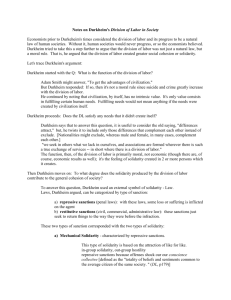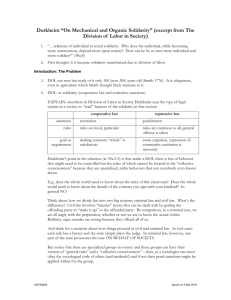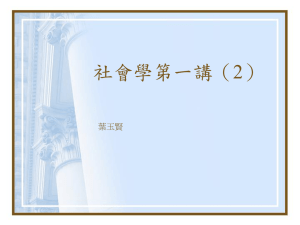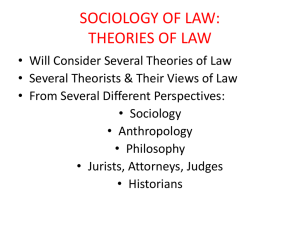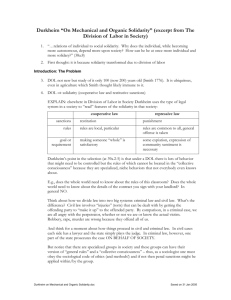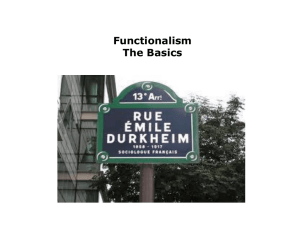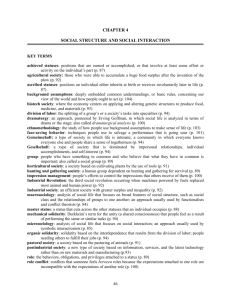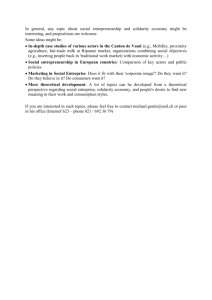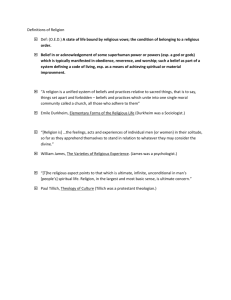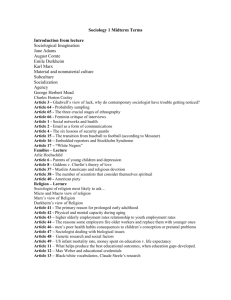Notes on Durkheim`s Division of Labor in Society
advertisement
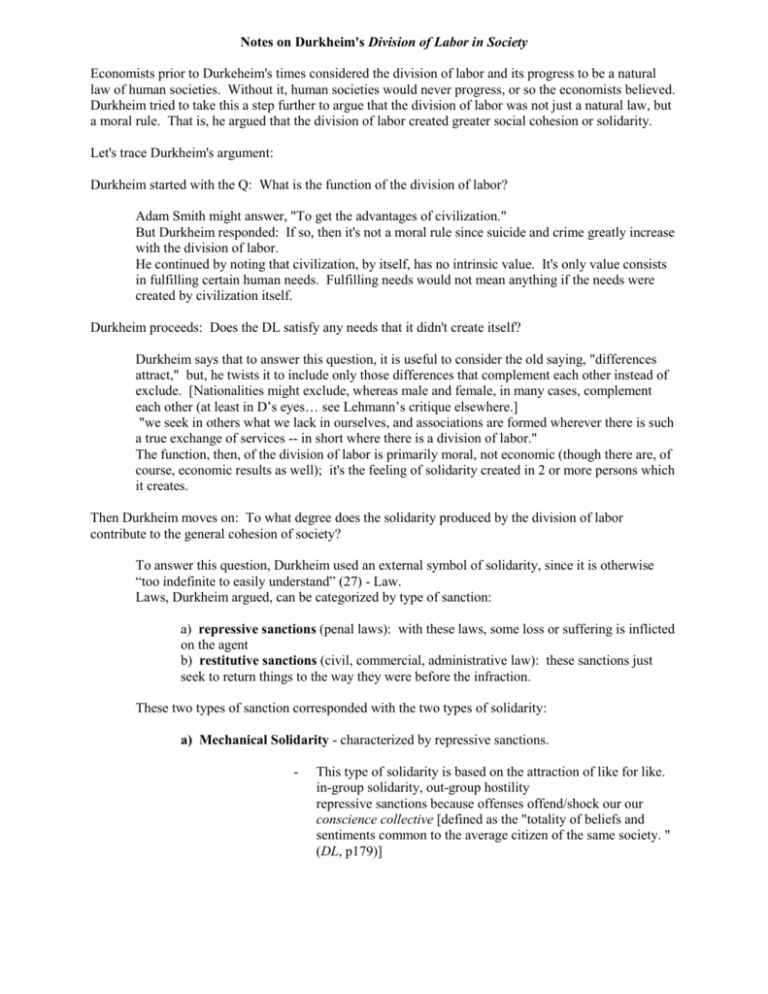
Notes on Durkheim's Division of Labor in Society Economists prior to Durkeheim's times considered the division of labor and its progress to be a natural law of human societies. Without it, human societies would never progress, or so the economists believed. Durkheim tried to take this a step further to argue that the division of labor was not just a natural law, but a moral rule. That is, he argued that the division of labor created greater social cohesion or solidarity. Let's trace Durkheim's argument: Durkheim started with the Q: What is the function of the division of labor? Adam Smith might answer, "To get the advantages of civilization." But Durkheim responded: If so, then it's not a moral rule since suicide and crime greatly increase with the division of labor. He continued by noting that civilization, by itself, has no intrinsic value. It's only value consists in fulfilling certain human needs. Fulfilling needs would not mean anything if the needs were created by civilization itself. Durkheim proceeds: Does the DL satisfy any needs that it didn't create itself? Durkheim says that to answer this question, it is useful to consider the old saying, "differences attract," but, he twists it to include only those differences that complement each other instead of exclude. [Nationalities might exclude, whereas male and female, in many cases, complement each other (at least in D’s eyes… see Lehmann’s critique elsewhere.] "we seek in others what we lack in ourselves, and associations are formed wherever there is such a true exchange of services -- in short where there is a division of labor." The function, then, of the division of labor is primarily moral, not economic (though there are, of course, economic results as well); it's the feeling of solidarity created in 2 or more persons which it creates. Then Durkheim moves on: To what degree does the solidarity produced by the division of labor contribute to the general cohesion of society? To answer this question, Durkheim used an external symbol of solidarity, since it is otherwise “too indefinite to easily understand” (27) - Law. Laws, Durkheim argued, can be categorized by type of sanction: a) repressive sanctions (penal laws): with these laws, some loss or suffering is inflicted on the agent b) restitutive sanctions (civil, commercial, administrative law): these sanctions just seek to return things to the way they were before the infraction. These two types of sanction corresponded with the two types of solidarity: a) Mechanical Solidarity - characterized by repressive sanctions. - This type of solidarity is based on the attraction of like for like. in-group solidarity, out-group hostility repressive sanctions because offenses offend/shock our our conscience collective [defined as the "totality of beliefs and sentiments common to the average citizen of the same society. " (DL, p179)] - - - - “we should not say that an act offends the common consciousness because it is criminal, but that it is criminal because it offends the common consciousness” (40) We react aggressively against those ideas and sentiments which contradict our own. This links the individual to the social order by virtue of his or her resemblance to others. MS is solidarity “deriving from resemblances, bind[ing] the individual directly to society” (61) Anything that offends collective sentiments in turn offends the collective itself, weakens society – that’s why even “victimless” crimes need to be punished (e.g., food laws) (62) Punishment needed not just to deter actors, but to (re)affirm the power of the CC Punishment protects society by producing atonement b) Organic Solidarity - characterized by laws with restitutive sanctions - Laws with restitutive sanctions must not have a strong source in the collective conscience. Instead, they have a source in the division of labor. - Goal is to restore the status quo - Presumes the differences of individuals - there has to be a sphere of action peculiar to the individual for these sanctions to exist [self-interest]. - That is, the conscience collective must leave part of the individual conscience untouched. The more the individual conscience is expanded, the greater the cohesion produced from this kind of solidarity. For any particular society, then, the ratio of laws with repressive sanctions to those with restitutive sanctions should be the same as the conscience collective to the division of labor. More "civilized" societies, Durkheim found, did, in fact, have fewer repressive sanctions - except for those types of repressive sanctions that protect the individual. Thus, the individual becomes the new religion - the last remaining piece of the collective conscience is the sanctity of the individual. More differences… (83-84) 1) MS links individual to society w/o intermediary; OS, individual depends on society b/c depends on parts that constitute it 2) MS: society is composed of beliefs and sentiments common to all; OS: society is system of different and special functions united by definite relationships (AND, these societies are not 2, but really one) 3) MS: can be strong to extent idea/tendencies common to all exceed in number and intensity those of the individual – solidarity at max when CC squeezes out the individual – 2 opposing forces, which cannot increase together: “if we have a strong inclination to think and act for ourselves we cannot be strongly inclined to think and act like other people” (84); OS: assumes that individuals are different from each other, CC leaves some space in individual consciousness, so that special functions can emerge, free of CC regulation. Changes in structural features of societies: The horde: This structure was seen in mechanical societies and is characterized by a homogeneous mass of indistinguishable parts. This structure was never seen in reality, but the clan had been. This was when the horde became a part of a more extensive group - basically, a number of hordes interacting with each other. The clan also was internally homogeneous and based on resemblances, not differences. Organized type: This structure was seen in organic societies. It was coordinated around a central organ [regulative action. Individuals place in this structure was determined by occupation instead of kin-group. This structure also was not anywhere observable in its true form. Causes of the Division of Labor: - not the desire for happiness [Durkheim wanted it to be sociological, not psychological]. Are we happier than those in more mechanical societies? - Instead it was due to an increase in dynamic or moral density: a) smaller geographic distance b/w members of a society b) smaller technological distance b/w members of a society c) sheer social volume of a society. These factors make the struggle for existence more acute. The only way to survive, Durkheim might argue, is differentiation/specialization - > then we each need different resources. Durkheim also discussed Pathological or Abnormal forms of the division of labor (Anomic and forced). These however, will be more easily discussed based on his next work - Suicide. lehmann’s durkheim and women - - - - - - repression of women by the text can be seen as a theoretical treatment of women – to ignore women is to reveal position on women he see’s women as “natural” and their current social position as their “place” sexual division of labor is doubly determined: by the “natural natures” of womean and men, and by the social functions these natures/differences serve for D, “sexual division of labor is necessary” (34) “the nature of women, according to D, is that they are natural, in a pejorative sense. For D, society is the progenitor of all that is mental and moral. Women are fundamentally, inherently, intrinsically asocial; they are asocial by nature and are therefore part of nature rather than part of society” (35) women comparable to “lower” “primitive” socieites; they are relatively immune to social forces – why he sees less suicide, less crime, less anomie in women women lack criminal opportunities due to their lack of integration in social life women simple, men complex the growing difference between men and women reflects general direction of human evolution – which determines a sexual division of labor (39) women cannot serve same functions in society as man, according to D division: one sex (W) takes care of affective functions in the private sphere, while the other the intllectual functions in the public sphere (M) family becomes less primitive by increasing differentiation, not through equality point of DoL: “specialized individuals are actually more highly integrated than identical individuals == that organic solidarity is more solidarity, and therefore more social, than mechanical solidarity” (43) D more interested in social and historical functions than their causes Subjugation of the wife is needed for “good conjugal discipline and the shared interests of the household” (47) “the structure of the relationship between women and men parallels the structure of the relationship among individuals in society. Primitively it is a relationship of similarity and equality. At the zenith of its evolution, it is structured by the sexual division of labor and by inequality” (48) sexual division of labor creates sexual and familial solidarity; it is functional, since it creates solidarity – family is “microcosmic replica of society” (49) – it strengthens and constitutes the society of men and women (50) D reject feminism as “unconscious movement” (51) – he sees sexual equality as primitive, unnatural, and dysfunctional. Bodies as sources of difference Tension between “individual and society” and between “nature and society”
